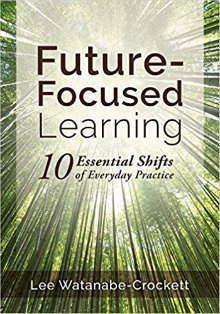10 Essential Shifts of Teaching Practice
Future-Focused Learning: 10 Essential Shifts of Everyday Practice
By Lee Watanabe-Crockett
(Solution Tree Press, 2019 – Learn more)

Much has been written on the topic of 21st century competencies, teaching, learning, and leadership and much will likely be written on this topic for many years to come.
A quick perusal of my bookshelf at work reveals at least 15 such volumes; a search of colleagues’ shelves would undoubtedly reveal even more.
So it was with some interest that I picked up Future-Focused Learning: 10 Essential Shifts of Everyday Practice by Lee Watanabe-Crockett. As a 21st century teaching and learning coordinator in my school district, I believe it is important for me to be exposed to as many thoughts on what it means to be a 21st century teacher and learner as possible.
After all, what works for one may not work for another and I need to be able to provide the tools and resources those in my district need to be successful.

Reconsidering your instructional practices
This is a book that will drive you to think deeply about your instructional practices, consider what you need to change, what should be kept in place, and what practices should be dropped. Each chapter provides an overview of the practice being discussed and suggestions for “microshifts” that can be used to implement the essential strategy.
With a summary and guiding questions for the reader at the end of each chapter, this would be an excellent text for a group of teachers to use as an extended book study or inquiry group while working on updating the teaching practices of the school or district.
10 essential shifts
The 10 essential shifts described in this book are as follows:
- using essential and herding questions,
- making emotional connections through context and relevance,
- personalizing learning,
- using higher-order questions,
- developing informational fluency,
- using process-oriented learning,
- providing clear success criteria,
- encouraging learner-created knowledge,
- using mindful assessment, and
- allowing for self- and peer-assessment.
While I do not intend to give a summary of all ten shifts, I will give an overview of some to provide a sense of what to expect.
When I saw the term “herding questions” in this book, my first thought was, “Oh, yet another author who can’t just use the same term that everyone else uses! Why can’t we just all say ‘essential questions’ instead of attaching a new adjective each time?!”
I was pleasantly surprised to learn that the author actually meant something quite different. Essential questions are what we want students to be able to answer as a result of their learning. However, as we make our classrooms more student-driven, they will occasionally go off-course. Herding questions help us gently redirect the class back to the original topic – literally herding their ideas.
From ‘just in case’ to ‘just in time’
This connects very well with another shift: personalized learning. Watanabe-Crockett suggests that we spend too much time in school teaching concepts and skills that are “just in case” students need them and not enough on what they need “just in time.” If we pay attention to what students are saying to us and to each other, we will be able to guide them to the learning that they need when they need it. (This doesn’t mean, of course, that we don’t teach concepts and skills that they may not need right here and now; it simply means that we need more “just in time” and less “just in case” learning.)
Just in time learning will also better prepare students to be savvy consumers of information. In our 21st century society, we are bombarded by conflicting messages at almost every moment. It is essential that we teach our students how to quickly and accurately analyze the information they are receiving and determine if it is worthwhile or not.
Where the author and I part ways
Those are a few examples of some of the points within this book that I greatly appreciated. But, as I wrote earlier, there were some parts that drove me crazy. Near the top of my list is the apparent dependence on using worksheets to assess students’ understanding of a concept or competency with a skill. (One of my sticky notes in the book simply says, “NO! NO MORE WORKSHEETS!”)
I also found myself frustrated by the number of times the author cited the same work, sometimes within the same paragraph, especially when that work was one of his previously published books. Maybe I am being overly critical here, but I have been led to believe that authors should go out of their way to avoid self-references; I counted 11 unique self-references within this book. I also found it off-putting that he referenced Wikipedia articles 17 times. Are those reasons to disregarding the message of this book? No, definitely not. But the reader should be aware in case that is something that you, like me, would find distracting.
Teaching strategies worth pursuing
Overall, I think that Lee Watanabe-Crockett’s Future-Focused Learning does indeed provide insights into 21st century teaching and learning that we would all do well to consider. From changing the way we ask questions to the way we assess student learning, our focus needs to be on what students both need and want to learn and not so much on what we think they ought to learn.
As he says toward the end of the book, “one of education’s primary goals is to create fully capable, independent learners…. When learners enter the education system at or near age five, they are completely dependent on us. Our collective goal as teachers must be to ensure that by the time they leave us they no longer need us.”
I do not believe it is an overstatement at all to say that the ten essential shifts of everyday practice within this book will lead us closer to achieving that goal.
Alex T. Valencic, Ed.M., is the Curriculum Coordinator for 21st Century Teaching and Learning in Freeport, Illinois. He has taught professionally for over ten years. When not coordinating the century by working with K-12 teachers who are implementing project-based learning and inquiry strategies to support student communication, collaboration, creativity, and critical thinking, Valencic can likely be found reading, riding his bicycle, or spending time with his family and friends playing tabletop games. You can learn more about his adventures in teaching fourth grade by visiting his blog Adventures in the 21st Century or by following him on Twitter @alextvalencic. This is his ninth book review for MiddleWeb.


































